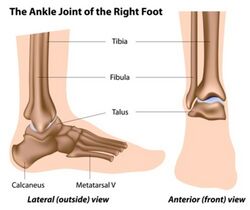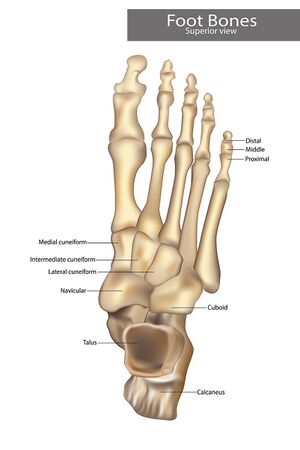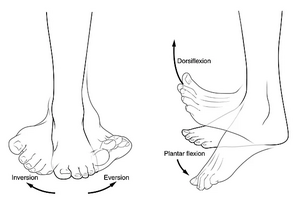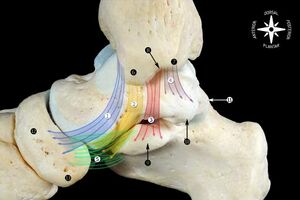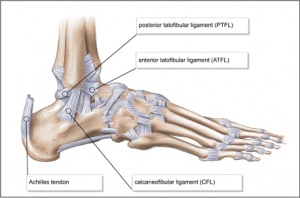Basic Foot and Ankle Anatomy - Bones and Ligaments
Original Editor - User Name
Top Contributors - Ewa Jaraczewska, Wanda van Niekerk, Jess Bell, Tarina van der Stockt, Niha Mulla, Kim Jackson and Olajumoke Ogunleye
Description[edit | edit source]
Ankle and foot injuries are fairly common not only within professional athletes or as a result of sporting activities, but they occur during routine daily activities. The typical injuries include sprains, fractures, tears, and inflammation. Good knowledge of the foot and ankle anatomy is necessary for proper diagnosis and treatment.
Structure[edit | edit source]
The ankle is formed by three bones: talus, tibia and fibula. The anatomic structure of the foot consists of hindfoot, midfoot and forefoot, each composed of several bones.
Ankle Bones[edit | edit source]
The lower leg and the foot constitute the ankle. The following bony elements of the ankle joint are part of this structure:
Foot bones[edit | edit source]
Talus and calcaneus and two tarsal bones form the posterior aspect of the foot called hindfoot. The midfoot located between the hindfoot and forefoot is made up of five tarsal bones: navicular, cuboid, and medial, intermediate, and lateral cuneiforms. The most anterior aspect of the foot including metatarsals, phalanges, and sesamoid bones is called a forefoot. Each digit, except for the great toe, consists of a metatarsal and three phalanges. The great toe has two phalanges only.
Function[edit | edit source]
The foot and ankle provide various important functions which include bodyweight support, balance maintenance, shock absorption, response to ground reaction forces, or substitution for hand function in individuals with upper extremity amputation.[1]It has a crucial role in gait and posture and its malalignment can cause problems eg., back pain or mobility limitations.[2][3]
Ankle and Foot Articulations[edit | edit source]
Talocrural joint (TC or sometimes called a tibiotalar joint) is referred to as the ankle joint. The joint is framed laterally and medially by the lateral and the medial malleolus and from the top by the tibia and the talus. [4]Saggital plane dorsiflexion and plantarflexion are the primary movements in this joint.
The hindfoot has a talus and calcaneus articulation called a subtalar joint (ST, also known as the talocalcaneal joint). Three facets of the talus and of the calcaneus are part of this joint. The main motions are inversion and eversion of the ankle and hindfoot.
The talonavicular and calcaneocuboid joints are known as a Chopart joint (MT, midtarsal or transverse tarsal joint) is located between the hindfoot and midfoot. This joint allows forefoot rotation. The navicular and all three cuneiform bones compose articulation distally. In addition to the navicular and cuneiforms bones, the cuboid bone has a distal articulation with the base of the fourth and fifth metatarsal bones.
The tarsometatarsal joint (TMT or Lisfranc joint)connecting the midfoot with forefoot originates from the lateral, intermediate and medial cuneiforms articulating with the bases of the three metatarsal bone (1st, 2nd, and 3rd). The small movement that occurs in the joint is described as dorsal and plantarflexion. [5]The bases of the remaining metatarsal bones(4th and 5th) connect with the cuboid bone. [4]
The five rays, metatarsal and corresponding phalanges create forefoot medial and lateral columns where rays 1,2, and 3 belong to the middle column, rays 4 and 5 to the lateral column. Metatarsophalangeal joints (MTP joints) are the main components of the forefoot. [4] Each toe, except of the great toe, has proximal and distal IP joints. The latter has only one IP joint.
Below is the summary of the ankle and foot articulation.
| Joint | Type of Joint | Plane of Movement | Motion |
|---|---|---|---|
| TC joint | Hinge | Sagittal | Dorsiflexion & Plantarflexion |
| ST joint | Condyloid |
Mainly transverse Some sagittal |
Inversion & Eversion Dorsiflexion & Plantarflexion |
| MT joint |
TN joint - Ball and socket CC joint - Modified saddle |
Largely in transverse Some sagittal |
Inversion & Eversion Flexion & Extension Forefoot rotation |
| TMT joint | Planar | ||
| MTP joint | Condyloid |
Sagittal Some Transverse |
Flexion & Extension Abduction & Adduction |
| IP joint | Hinge | Sagittal | Flexion & Extension |
Ligaments[edit | edit source]
Acute and chronic ankle pains are often associated with either ligament injury or ligament laxity.[6]The ligaments of the ankle consist of the medial side ligaments (the deltoid ligament), the lateral ligaments, and the ligaments connecting the distal epiphyses of the tibia and fibula called the tibiofibular syndesmosis. [6]
There are 4 main ligaments of the foot including plantar fascia ligament, plantar calcaneonavicular ligament (known as a spring ligament), calcaneocuboid ligament, and Lisfranc ligaments.
Medial Collateral Ligament (Deltoid Ligament)[edit | edit source]
There are various descriptions of the medial collateral ligament(MCL), but the definition provided by Milner and Soames (1998) is the most commonly accepted.[7]The authors divide the MCL into two layers: superficial and deep layers with bands either always present or which presence will vary (bands that are always present are in italic):
- Superficial: tibiospring ligament, tibionavicular ligament, superficial posterior tibiotalar ligament, tibiocalcaneal ligament
- Deep: deep posterior tibiotalar ligament, deep anterior tibiotalar ligament
It is important to mention that the dissection revealed the continuous nature of these ligaments and individual bands were impossible to distinguish[6].
The characteristic of the MCL:
- multifascicular
- originates from the medial malleolus and inserts in the talus
- tendon sheath of the posterior tibial muscle covers the posterior and middle part of the deltoid ligament
- tendons covers most of the MCL as it inserts at the foot.[6]
Lateral Collateral Ligament[edit | edit source]
Lateral collateral ligament (LCL) form three ligaments: anterior talofibular, calcaneofibular , and posterior talofibular ligaments.
Anterior talofibular ligament (ATFL):
- is made up of two bands
- originates at the anterior margin of the lateral malleolus and insert on the talus
- lays horizontally to the ankle
- limits anterior displacement of the talus and ankle plantarflexion
- weakest part of the LCL[8]
Calcaneofibular ligament (CL):
- originates from the anterior part of the lateral malleolus and attaches to the posterior region of the lateral calcaneal surface
- located below the lower band of the anterior talofibular ligament
- runs obliquely downwards and backwards
- bridges the talocrural joint and subtalar joint
- allows talocrural joint flexion and extension and subtalar movement
Posterior Talofibular Ligament (PTFL):
- originates from the malleolar fossa and inserts in the posterolateral talus
- some fibres become involved in forming the tunnel for the flexor hallucis longus tendon
- runs almost horizontally
- at the neutral ankle and during plantarflexion, the ligament is relaxed, in dorsiflexion taut.
There are interconnections between the ATFL, CFL, and PTFL that lead to the formation of an anatomical and functional lateral fibulotalocalcaneal ligament complex.[8] [9]
Tibiofibular Syndesmosis[edit | edit source]
This articulation allows medial rotation of the fibula during maximum ankle dorsiflexion and inversion of the fibula during ankle plantarflexion. In addition it provides stability between the tibia and the fibula at their distal ends. It includes:
- anteroinferior tibiofibular ligament
- posteroinferior tibiofibular ligament
- interosseous tibiofibular ligament.
A fatty synovial fringe located distal to the ligament insertion is also part of this structure. It's upward and downward movement occurs during ankle movement and alters its placement between the tibia and the fibula. This adipose tissue is considered a cause of a syndesmotic impingement following ankle sprain.
Ligaments of the Foot[edit | edit source]
Muscle attachments[edit | edit source]
Watch this short video on ankle and foot palpation
Vascular Supply[edit | edit source]
Nerve Supply[edit | edit source]
Clinical relevance[edit | edit source]
Resources[edit | edit source]
References[edit | edit source]
- ↑ Houglum PA, Bertotti DB. Brunnstrom's clinical kinesiology. FA Davis; 2012
- ↑ Menz HB, Dufour AB, Riskowski JL, Hillstrom HJ, Hannan MT. Foot posture, foot function and low back pain: the Framingham Foot Study. Rheumatology (Oxford). 2013 Dec;52(12):2275-82.
- ↑ Menz HB, Dufour AB, Katz P, Hannan MT. Foot Pain and Pronated Foot Type Are Associated with Self-Reported Mobility Limitations in Older Adults: The Framingham Foot Study. Gerontology. 2016;62(3):289-95.
- ↑ 4.0 4.1 4.2 Ficke J, Byerly DW. Anatomy, Bony Pelvis and Lower Limb, Foot. [Updated 2021 Aug 11]. In: StatPearls [Internet]. Treasure Island (FL): StatPearls Publishing; 2021 Jan-. Available from: https://www.ncbi.nlm.nih.gov/books/NBK546698/
- ↑ Bähler A. The Biomechanics of the Foot. CPO 1986;10(1):8-14.
- ↑ 6.0 6.1 6.2 6.3 Golanó P, Vega J, de Leeuw PA, Malagelada F, Manzanares MC, Götzens V, van Dijk CN. Anatomy of the ankle ligaments: a pictorial essay. Knee Surg Sports Traumatol Arthrosc. 2010 May;18(5):557-69.
- ↑ Milner CE, Soames RW. Anatomy of the collateral ligaments of the human ankle joint. Foot Ankle Int. 1998 Nov;19(11):757-60.
- ↑ 8.0 8.1 Szaro P, Ghali Gataa K, Polaczek M. et al. The double fascicular variations of the anterior talofibular ligament and the calcaneofibular ligament correlate with interconnections between lateral ankle structures revealed on magnetic resonance imaging. Sci Rep 2020;10: 20801.
- ↑ Dalmau-Pastor M, Malagelada F, Calder J, Manzanares MC, Vega J. The lateral ankle ligaments are interconnected: the medial connecting fibres between the anterior talofibular, calcaneofibular and posterior talofibular ligaments. Knee Surg Sports Traumatol Arthrosc. 2020 Jan;28(1):34-39.
- ↑ Ankle and foot palpation. 2012 Available from: https://www.youtube.com/watch?v=aJRemQbNPhk [last accessed 18/12/2021]
